
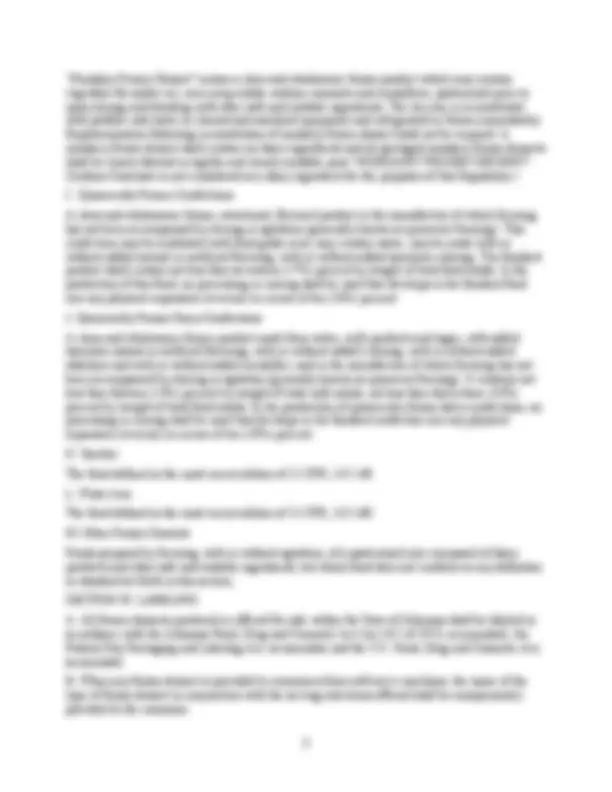
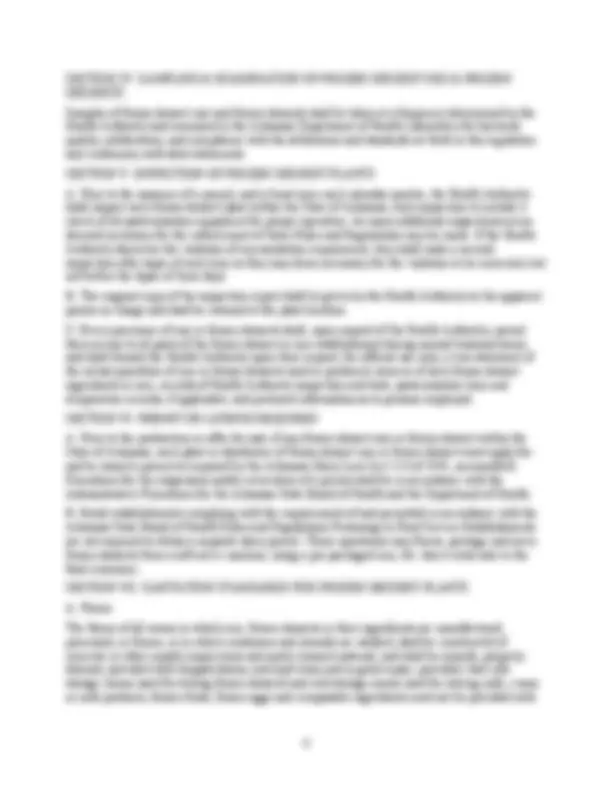
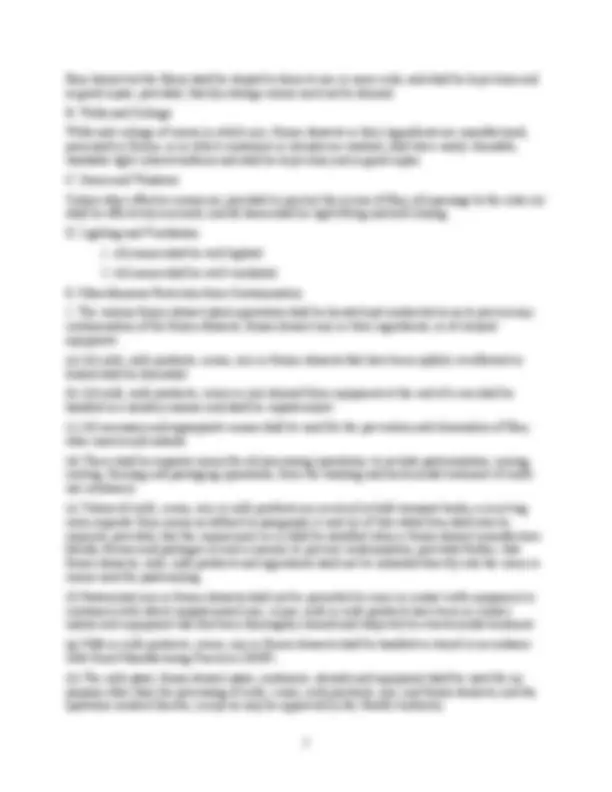
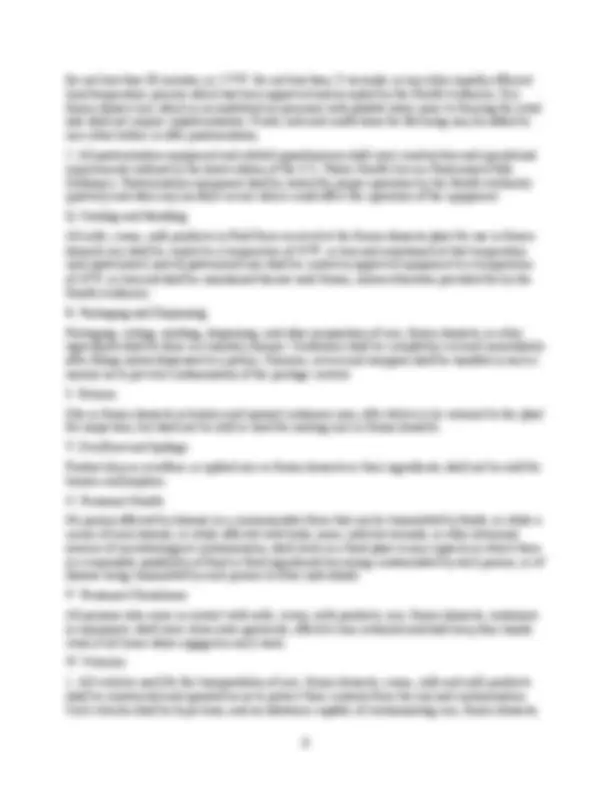
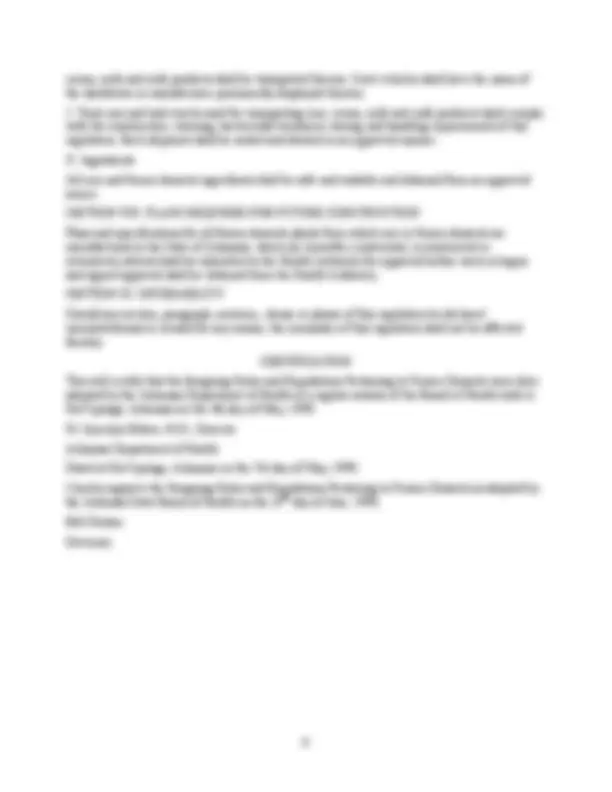


Study with the several resources on Docsity

Earn points by helping other students or get them with a premium plan


Prepare for your exams
Study with the several resources on Docsity

Earn points to download
Earn points by helping other students or get them with a premium plan
Community
Ask the community for help and clear up your study doubts
Discover the best universities in your country according to Docsity users
Free resources
Download our free guides on studying techniques, anxiety management strategies, and thesis advice from Docsity tutors
The regulations set by the Arkansas Department of Health for the production and sale of frozen desserts, including frozen yogurt and nonfat frozen yogurt. Topics covered include sampling and examination, plant operations, sanitation, and personnel cleanliness.
What you will learn
Typology: Lecture notes
1 / 9

This page cannot be seen from the preview
Don't miss anything!






Table of Contents
SECTION I. DEFINITIONS .............................................................................................................. 1
SECTION II. DEFINITIONS & STANDARDS OF IDENTITY FOR FROZEN DESSERTS ........ 2
SECTION III. LABELING................................................................................................................. 3
SECTION IV. SAMPLING & EXAMINATION OF FROZEN DESSERT MIX & FROZEN DESSERTS ......................................................................................................................................... 4
SECTION V. INSPECTION OF FROZEN DESSERT PLANTS ..................................................... 4
SECTION VI. PERMIT OR LICENSE REQUIRED......................................................................... 4
SECTION VII. SANITATION STANDARDS FOR FROZEN DESSERT PLANTS. ..................... 4
SECTION VIII. PLANS REQUIRED FOR FUTURE CONSTRUCTION....................................... 9
SECTION IX. SEVERABILITY........................................................................................................ 9
The following Rules and Regulations Pertaining to Frozen Desserts are duly promulgated and adopted by the Arkansas State Board of Health pursuant to the authority expressly conferred by Laws of the State of Arkansas including, without limitation, Act 96 of 1913, as amended (Ark. Code. Ann. § 20-7-109), Act 114 of 1941 (Ark. Code. Ann. § 20-59-201 et seq.), Act 416 of 1953 (Ark. Code Ann. § 20-59-201), and Act 27 of 1989 (Ark. Code Ann. § 20-59-205).
SECTION I. DEFINITIONS
For the purpose of this Regulation, its interpretation, and its application, the following definitions and standards shall apply:
A. Health Authority : The Director, Arkansas Department of Health, or his/her designated representative.
B. Novelties : Frozen desserts, either alone or in combination with other foods such as cookies, wafers, cones, coating, confections, etc., which are packaged in single-serving units.
C. Overrun : The trade expression used to refer to the increase in volume of the frozen product over the volume of the mix. This increase in volume is due to air being whipped into the product during the freezing process. It is expressed as percent increase of the volume of the mix.
D. Pasteurization : The process of heating, in approved and properly operated equipment, every particle of mix to the following temperature and holding for the specified time: 155° F. for 30 minutes, or 175° F. for 25 seconds (or other time/temperature relationship which has been demonstrated to be equivalent thereto in microbial destruction).
E. Safe and Suitable : Ingredients approved by the Federal Food & Drug Administration for use in food for human consumption, which perform an appropriate function in the food in which they are used, and are used at a level no higher than necessary to achieve their intended purpose in the food.
F. Frozen Dessert : Any frozen substance, mixture, or compound as defined in Section II of this Regulation; or any frozen substance, mixture or compound made in semblance of any item set forth herein, but which does not conform in each and every particular to one of the stated definitions, and may be made from ingredients listed in the definitions herein and/or other safe and suitable ingredients. The substance, mixture or compound before freezing shall be known as a mix for the respective frozen dessert that results when the mix is frozen.
SECTION II. DEFINITIONS & STANDARDS OF IDENTITY FOR FROZEN DESSERTS
A. Frozen Dietary Dessert and Frozen Dietary Dairy Dessert
A food for any special dietary use, prepared by freezing, with or without agitation, composed of a pasteurized mix which may contain milkfat and/or edible vegetable fats or oils, protein, carbohydrates, flavoring, stabilizers, emulsifiers, vitamins and minerals.
B. Frozen Yogurt
Means freezing while stirring a product resulting from the fermentation by specific lactic acid producing bacteria of a pasteurized or ultra pasteurized mixture of milk and other optional ingredients approved for use in ice cream or ice milk. Frozen yogurt, before the addition of fruit or other bulky flavors, shall not contain less than 3.25 percent milkfat and not less than 8.25 percent milk solids not fat. After the addition of fruit or other bulky flavors, it shall contain not less than 2. percent milkfat. All ingredients used shall be safe and suitable. If produced for freezing in soft serve machines, the product shall be FROZEN YOGURT MIX.
C. Lowfat Frozen Yogurt
Means freezing while stirring a product resulting from the fermentation by specific lactic acid producing bacteria of a pasteurized or ultra pasteurized mixture of lowfat milk and other optional ingredients approved for used in ice cream or ice milk, containing not less than 1/2 percent nor more than 2 percent milkfat, with not less than 8.25 percent milk solids not fat. All ingredients used shall be safe and suitable. If produced for freezing in soft serve machines, the product shall be LOWFAT FROZEN YOGURT MIX.
D. Nonfat Frozen Yogurt
Means freezing while stirring a product resulting from the fermentation by specific lactic acid producing bacteria of a pasteurized or ultra pasteurized mixture of nonfat milk and other optional ingredients approved for use in ice cream or ice milk, containing less than 1/2 percent milkfat, with not less than 8.25 percent milk solids not fat. All ingredients used shall be safe and suitable. If produced for freezing in soft serve machines, the product shall be NONFAT FROZEN YOGURT MIX.
E. Ice Cream and Frozen Custard
The foods defined in the most recent edition of 21 CFR, 135.110.
F. Ice Milk
The food defined in the most recent edition of 21 CFR, 135.120.
G. Mellorine
The food defined in the most recent edition of 21 CFR, 135.130.
H. Nondairy Frozen Dessert
Samples of frozen dessert mix and frozen desserts shall be taken at a frequency determined by the Health Authority and examined in the Arkansas Department of Health Laboratory for bacterial quality, adulteration, and compliance with the definitions and standards set forth in this regulation and conformity with label statements.
SECTION V. INSPECTION OF FROZEN DESSERT PLANTS
A. Prior to the issuance of a permit, and at least once each calendar quarter, the Health Authority shall inspect each frozen dessert plant within the State of Arkansas; such inspection to include a check of all pasteurization equipment for proper operation. As many additional inspections as are deemed necessary for the enforcement of these Rules and Regulations may be made. If the Health Authority discovers the violation of any sanitation requirement, they shall make a second inspection after lapse of such time as they may deem necessary for the violation to be corrected, but not before the lapse of three days.
B. The original copy of the inspection report shall be given by the Health Authority to the apparent person in charge and shall be retained at the plant location.
C. Every processor of mix or frozen desserts shall, upon request of the Health Authority, permit them access to all parts of the frozen dessert or mix establishment during normal business hours, and shall furnish the Health Authority upon their request, for official use only, a true statement of the actual quantities of mix or frozen desserts used or produced, sources of such frozen dessert ingredients or mix, records of Health Authority inspection and tests, pasteurization time and temperature records, if applicable, and pertinent information as to persons employed.
SECTION VI. PERMIT OR LICENSE REQUIRED
A. Prior to the production or offer for sale of any frozen dessert mix or frozen dessert within the State of Arkansas, each plant or distributor of frozen dessert mix or frozen dessert must apply for and be issued a permit as required by the Arkansas Dairy Law (Act 114 of 1941, as amended). Procedures for the suspension and/or revocation of a permit shall be in accordance with the Administrative Procedures for the Arkansas State Board of Health and the Department of Health.
B. Retail establishments complying with the requirements of and permitted in accordance with the Arkansas State Board of Health Rules and Regulations Pertaining to Food Service Establishments are not required to obtain a separate dairy permit. These operations may freeze, package and serve frozen desserts from a soft-serve machine, using a pre-packaged mix, for direct retail sale to the final consumer.
SECTION VII. SANITATION STANDARDS FOR FROZEN DESSERT PLANTS.
A. Floors
The floors of all rooms in which mix, frozen desserts or their ingredients are manufactured, processed, or frozen, or in which containers and utensils are washed, shall be constructed of concrete or other equally impervious and easily cleaned material, and shall be smooth, properly drained, provided with trapped drains, and kept clean and in good repair; provided, that cold storage rooms used for storing frozen desserts and cold storage rooms used for storing milk, cream or milk products, frozen fruits, frozen eggs and comparable ingredients need not be provided with
floor drains but the floors shall be sloped to drain to one or more exits, and shall be kept clean and in good repair; provided, that dry storage rooms need not be drained.
B. Walls and Ceilings
Walls and ceilings of rooms in which mix, frozen desserts or their ingredients are manufactured, processed or frozen, or in which containers or utensils are washed, shall have easily cleanable, washable light colored surfaces and shall be kept clean and in good repair.
C. Doors and Windows
Unless other effective means are provided to prevent the access of flies, all openings to the outer air shall be effectively screened, and all doors shall be tight fitting and self-closing.
D. Lighting and Ventilation
E. Miscellaneous Protection from Contamination
(a) All milk, milk products, cream, mix or frozen desserts that have been spilled, overflowed or leaked shall be discarded.
(b) All milk, milk products, cream or mix drained from equipment at the end of a run shall be handled in a sanitary manner and shall be repasteurized.
(c) All necessary and appropriate means shall be used for the prevention and elimination of flies, other insects and rodents.
(d) There shall be separate rooms for all processing operations, to include pasteurization, mixing, cooling, freezing and packaging operations, from the washing and bactericidal treatment of multi- use containers.
(e) Unless all milk, cream, mix or milk products are received in bulk transport tanks, a receiving room separate from rooms as defined in paragraph (i) and (ii) of this subsection shall also be required; provided, that the requirement in (i) shall be satisfied when a frozen dessert manufacturer blends, freezes and packages in such a manner to prevent contamination; provided further, that frozen desserts, milk, milk products and ingredients shall not be unloaded directly into the room or rooms used for pasteurizing.
(f) Pasteurized mix or frozen desserts shall not be permitted to come in contact with equipment or containers with which unpasteurized mix, cream, milk or milk products have been in contact, unless such equipment has first been thoroughly cleaned and subjected to a bactericidal treatment.
(g) Milk or milk products, cream, mix or frozen desserts shall be handled or stored in accordance with Good Manufacturing Practices (GMP).
(h) The milk plant, frozen dessert plant, containers, utensils and equipment shall be used for no purpose other than the processing of milk, cream, milk products, mix, and frozen desserts, and the operation incident thereto, except as may be approved by the Health Authority.
All piping and fittings used to conduct milk, cream, milk products, mix or frozen desserts shall be of sanitary design and construction which meets 3-A Sanitary standards and accepted procedures. Mix, frozen desserts, fluid milk products and ingredients shall be conducted from one piece of equipment to another only by sanitary piping and fittings.
J. Construction and Repair of Containers, Utensils and Equipment
K. Disposal of Wastes
All wastes shall be disposed of in a sanitary manner. All plumbing and appurtenances thereto shall be so designed and installed as to prevent the contamination of frozen desserts or any ingredient, utensil, container or equipment by drip, condensation or backflow.
L. Cleaning and Bactericidal Treatment of Multi-Use Utensils, Containers, and Equipment
All multi-use utensils, containers and equipment shall be thoroughly cleaned before each usage. All product-contact surfaces of multi-use utensils, containers and equipment shall be subjected effectively to an approved bactericidal process prior to use. Multi-use containers used for the transportation of mix shall be thoroughly rinsed immediately after use. Storage tanks and silos shall be emptied and cleaned and sanitized within each 72-hour period. If processing equipment is in continuous 24-hour operation, it should be shut down, drained, cleaned and sanitized daily.
M. Storage of Multi-Use Utensils, Containers and Equipment
After cleaning, all multi-use utensils, containers and equipment shall be stored to drain dry, and in such a manner as not to be contaminated before usage.
N. Storage of Single-Service Containers, Utensils and Materials
Caps, parchment papers, wrappers, liners, gaskets, and single-service sticks, spoons, covers and containers for frozen desserts, mix or their ingredients shall be purchased and stored only in sanitary tubes, wrappings, or cartons; shall be kept therein in a clean, dry place until used; and shall be handled in a sanitary manner. Re-use of single-service articles is prohibited.
O. Handling of Containers and Equipment
Between bactericidal treatment and usage, and during usage, containers and equipment shall not be handled or operated in such a manner as to permit contamination of the mix, frozen desserts or their ingredients. Pasteurized mix and frozen desserts shall not be permitted to come into contact with equipment with which unpasteurized mix, milk, cream or milk products have been in contact, unless the equipment has been thoroughly cleaned and effectively subjected to an approved bactericidal process.
P. Pasteurization of Mix
for not less than 30 minutes; or 175°F. for not less than 25 seconds; or any other equally efficient time/temperature process which has been approved and accepted by the Health Authority. Dry frozen dessert mix which is reconstituted on premises with potable water prior to freezing for retail sale shall not require repasteurization. Fruits, nuts and confections for flavoring may be added to mix either before or after pasteurization.
Q. Cooling and Handling
All milk, cream, milk products in fluid form received at the frozen desserts plant for use in frozen desserts mix shall be cooled to a temperature of 45°F. or less and maintained at that temperature until pasteurized; and all pasteurized mix shall be cooled in approved equipment to a temperature of 45°F. or less and shall be maintained thereat until frozen, unless otherwise provided for by the Health Authority.
R. Packaging and Dispensing
Packaging, cutting, molding, dispensing, and other preparation of mix, frozen desserts, or other ingredients shall be done in a sanitary manner. Containers shall be completely covered immediately after filling unless dispensed to a patron. Closures, covers and wrappers shall be handled in such a manner as to prevent contamination of the package content.
S. Returns
Mix or frozen desserts in broken and opened containers may, after delivery, be returned to the plant for inspection, but shall not be sold or used for making mix or frozen desserts.
T. Overflow and Spillage
Product drip or overflow, or spilled mix or frozen desserts or their ingredients, shall not be sold for human consumption.
U. Personnel Health
No person affected by disease in a communicable form that can be transmitted by foods, or while a carrier of such disease, or while affected with boils, sores, infected wounds, or other abnormal sources of microbiological contamination, shall work in a food plant in any capacity in which there is a reasonable possibility of food or food ingredients becoming contaminated by such person, or of disease being transmitted by such person to other individuals.
V. Personnel Cleanliness
All persons who come in contact with milk, cream, milk products, mix, frozen desserts, containers or equipment, shall wear clean outer garments, effective hair restraints and shall keep their hands clean at all times while engaged in such work.
W. Vehicles